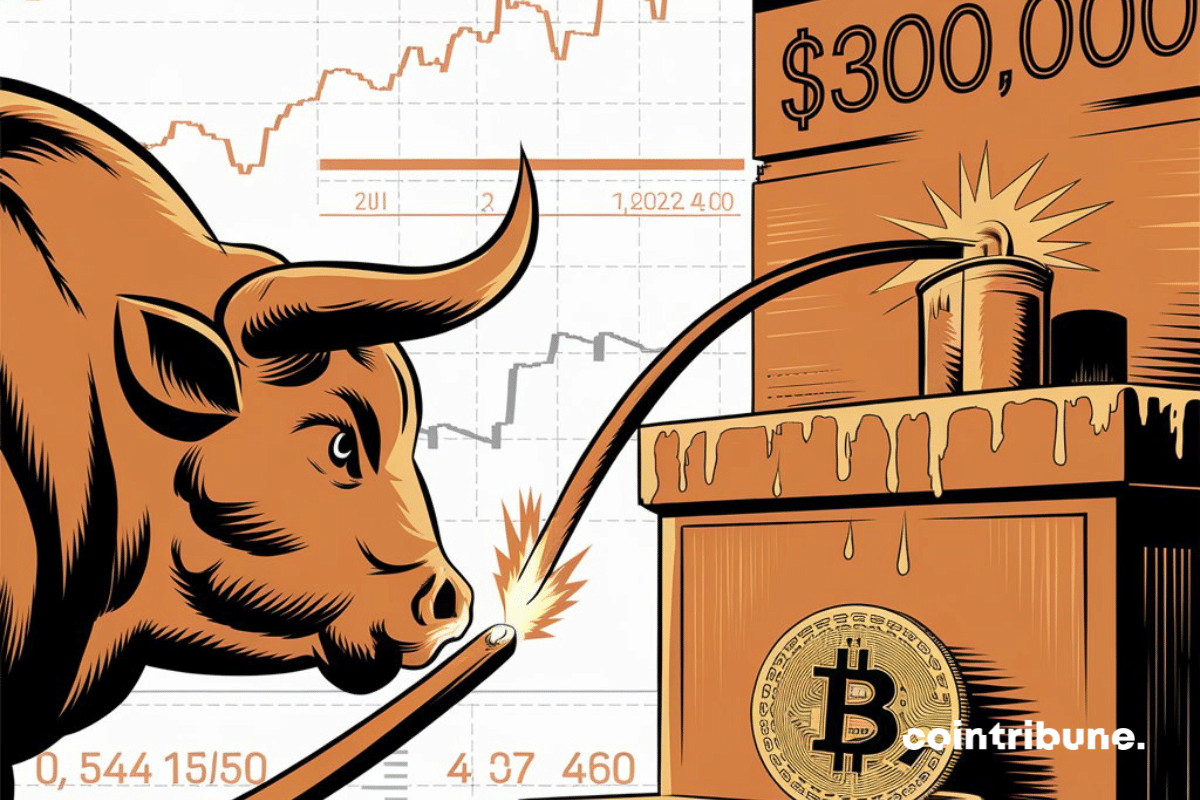In a context where Bitcoin reaches historic highs beyond 81,000 dollars, MicroStrategy sees its investment strategy paying off with a return on investment now exceeding 100%.
Theme Bitcoin (BTC)
Amid revolutionary announcements, technological advancements, and regulatory turbulence, the crypto ecosystem continues to prove that it is both a territory of limitless innovations and a battleground of regulatory and economic issues. Here is a summary of the most significant news from the past week surrounding Bitcoin, Ethereum, Binance, Solana, and Ripple.
If you have just started to explore the world of Bitcoin, you have surely come across various technical terms that are difficult to understand. Today, we will discuss Proof of Work, the consensus mechanism that ensures the security of Bitcoin. But you are probably wondering: How does it work? Discover in this guide all the inner workings of the most widely used validation mechanism in cryptographic systems.
The entire technology surrounding the Bitcoin ecosystem continues to fascinate us. Every element and feature is important for ensuring the proper functioning, security, and decentralization of the network. This is the case with the hashrate, which is a measure of the total computational power required by the Bitcoin network to validate new blocks. The hashrate is essential for the Bitcoin mining process. But what exactly is it? How does it work? And above all, what is it used for?
Victim of its success, the Bitcoin network faces congestion problems: cryptocurrency transactions take longer to be validated and fees are higher. It is in this context that Segwit came into being, bearing the improvement proposal number BIP141. This is a soft fork of Bitcoin that helps to address the scalability of the network. In addition to improving the performance of the ecosystem, this upgrade has also brought better security to transactions. But how does Segwit actually improve the BTC blockchain? We explain everything in this comprehensive guide.
The Bitcoin blockchain is a distributed ledger technology that underpins the first and most iconic cryptocurrency: Bitcoin. Since its creation in 2009, it has sparked global interest, challenging our conception of money and transactions. With its growth, debates have intensified around its environmental impact and its ability to scale without compromising its principles of decentralization. This article reveals the mechanisms of the Bitcoin blockchain, clarifying its complex functioning and practical implications for users and society as a whole.
Since its creation in 2009, Bitcoin (BTC) has faced scalability challenges and transaction fees. To address this, several hard forks have emerged, including Bitcoin Cash (BCH). This digital currency was born with the aim of improving scalability and transaction efficiency. Let's take a deep dive into the history of BCH, its advantages and disadvantages, as well as its potential uses and development prospects.
Bitcoin, with its decentralized architecture, has revolutionized the world of blockchain. However, its operation relies on considerable electricity consumption, raising questions about the sustainability of this system. This article explores the energy mechanisms of Bitcoin and examines the factors influencing its electricity consumption. It assesses the environmental consequences of Bitcoin's energy consumption and discusses potential solutions for a greener future.
Bitcoin SV (BSV), which stands for "Bitcoin Satoshi Vision", is a cryptocurrency that emerged in November 2018 following a hard fork of the Bitcoin Cash (BCH) protocol. Since then, it has become one of the most valued cryptocurrencies in the crypto market, with an increasingly growing adoption. To better understand the potential of this digital currency, let us take a closer look at its origins, technical characteristics, ecosystem, as well as the investment opportunities and challenges it faces.
Bitcoin Diamond (BCD) is one of the major blockchain projects that emerged following a hard fork of Bitcoin (BTC). It was designed with the aim of overcoming certain challenges faced by its predecessor. In this article, we will examine the history, functionality, and potential benefits of BCD. Finally, we will explore how Bitcoin Diamond could evolve and develop in the future within an increasingly competitive cryptocurrency market.
Bitcoin Gold (BTG) is a cryptocurrency project that resulted from a hard fork of Bitcoin (BTC). It was created with the aim of making mining more accessible. Since its launch, this project has been adopted by several exchange platforms and crypto wallets. In this article, we will explore in detail the origins of BTG and how it works. We will also attempt to determine what the future holds for this digital asset, which has been gaining ground in the cryptocurrency market for several years.
Bitcoin (BTC) has revolutionized the financial world by offering a decentralized alternative to traditional online transactions. Since its launch in 2009, it has attracted a large community of users and developers, but it has also faced debates on how to evolve and develop. To resolve these differences, some members of the community have chosen to fork the Bitcoin blockchain. What does this term refer to? What are the different types of forks and how do they work? What are the impacts for users and miners? Let’s explore the world of forks together to deepen our understanding of how Bitcoin operates.
Data security is a crucial issue, especially in a digital world where hacking and privacy breaches are becoming increasingly prevalent. To ensure the protection of digital files, one of the most effective means is the use of hashing algorithms. These have the particularity of transforming any type of data into a unique digital fingerprint that preserves its integrity. In this article, we will explain how this fingerprint is calculated for a file. For this practical case, we will use SHA-256, the hashing algorithm used by the Bitcoin protocol. But first, let's explore the fundamentals of hashing in general, and SHA-256 in particular.
Merkle trees are a fundamental element of blockchain technology. They are used by most protocols, starting with Bitcoin, which relies on the Proof-of-Work consensus mechanism. However, they are utilized by most protocols to ensure the security and integrity of data on the network. If you are interested in the queen of cryptocurrencies, you have probably heard of them, but without really grasping how they work. In this article, we will explain to you precisely and in detail what Merkle trees are and their utility for the Bitcoin network. You will also discover the limitations and prospects of this technology.
Surpriiiise: Bitcoin could soar to $300,000! Experts are rejoicing, bears are crying, and Wall Street is finally applauding.
"Big crisis, big doubts!" Musk already sees America in ruins... unless a bit of Bitcoin comes to solve everything!
Bitcoin continues its meteoric rise in 2024, reaching a new historic high of $80,116 this Sunday, November 10. This exceptional performance comes against a backdrop marked by the recent reelection of Donald Trump and a massive influx of institutional investments through Bitcoin ETFs.
Solana climbs, climbs, and soon touches the grail of 100 billion. Trump applauds, the crypto world holds its breath!
Bitcoin continues its wild ride, reaching a new all-time high of $79,141, as market experts urge investors to keep their cool in this highly bullish context.
Excitement in the crypto zoo: Bitcoin pulls back, altcoins tease an ascent. Breathless suspense, verdict soon, it promises!
Bitcoin is reaching new heights, now flirting with the $77,000 mark, a feat largely driven by the announcement of Donald Trump's victory in the U.S. presidential elections. In a context of high volatility, where institutional players and analysts sharpen their projections, the famous stock-to-flow model by analyst PlanB now forecasts a potential surge in Bitcoin's price up to $500,000 by the next four-year cycle. This renewed institutional interest, supported by favorable political initiatives, promises to disrupt the crypto market.
As Bitcoin continues to captivate investors worldwide by flirting with new historical highs, an unexpected voice rises to temper the euphoria surrounding the queen of crypto: that of Ki Young Ju, CEO of CryptoQuant, a benchmark in the industry. In a context where markets are buoyed by the prospect of Fed rate cuts and the repercussions of the recent U.S. presidential elections, Ki Young Ju makes a strange and far from optimistic prediction. According to him, Bitcoin could experience a drop of nearly 24% by the end of 2024, with a level around $58,974. This prediction, although out of step with the current enthusiasm, is based on a meticulous analysis of past trends and market data.
Bitcoin is establishing itself as a strong player in the market! BlackRock, abandoning gold, is swimming in crypto green. A true idol reversal!
As the price of Bitcoin reaches historic highs, having nearly touched 77,000 dollars yesterday, Friday, November 8, 2024, investors are faced with a critical question: is this rapid rise supported by real value, or is the market already hitting its limits? In a price discovery phase where traditional benchmarks seem to dissolve, analyses on on-chain metrics allow for a better understanding of the underlying potential of the most emblematic cryptocurrency. Five key indicators show that, despite this peak, Bitcoin remains fundamentally undervalued.
Trump at the helm and here comes Bitcoin sparking: BlackRock scoops up billions, everything is rolling for the ETF!
In a move that would have seemed like science fiction a few years ago, Detroit is preparing to welcome cryptocurrency into its municipal coffers. Starting in mid-2025, residents of this city in full resurgence will be able to pay their taxes and other municipal fees in Bitcoin, Litecoin, and perhaps…
The Russian government has stepped into the bitcoin industry. This support is likely not unrelated to the ambition of bringing about a fairer international monetary system.
Trump at the helm and here comes Bitcoin sparking: BlackRock scoops up the billions, everything is going smoothly for the ETF!
The storm may be brewing for Bitcoin. This time, it is not the result of the usual market fluctuations, but of an analysis anticipating a drop that could shake investor confidence. As Bitcoin flirts with a new historical peak around $75,000, respected analyst Benjamin Cowen warns of a possible substantial drop in price. According to him, a reversal could take shape in early December, coinciding with the release of the U.S. employment report.
Bitcoin, a true barometer of alternative financial markets, has reached a historic milestone by surpassing the $76,800 mark. A staggering figure, indeed, but according to many analysts, it is just the first page of a book that promises to become a bestseller. So, why this meteoric rise, and what else…




























